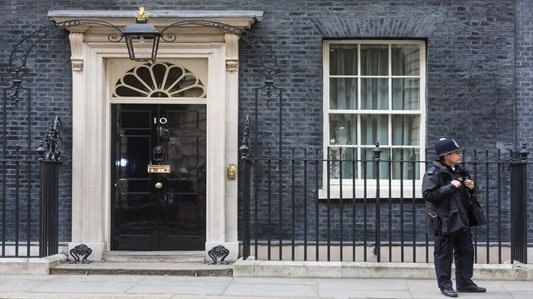Most people probably regard cabinet reshuffles as a bit of a yawn.
Politicians they’ve never heard of get moved about and then life goes on. But it’s not seen like that in Westminster. There the mood is feverish as the whole political tribe speculates excitedly about who will be in and who will be out, who will live, who will die.
For journalists it’s a compelling soap opera. But the figure for whom it is most important is the prime minister. It is an opportunity for the person at the top to reassert authority, to redefine the government’s purpose and to improve its image. All these things, we were told, were Theresa May’s ambitions when she reshuffled her Cabinet on Monday. But the result has been described even by people on her own side as ‘embarrassing’, ‘shambolic’ and as leaving the government looking much as it did before. Has the reshuffle served merely to confirm Mrs May’s image as blunder-prone and not up to the job, or will it ultimately not much matter?
One of the problems with reshuffles is the word itself. There’s something inherently trivial, even pathetic about shuffling, suggesting the idleness of a card game or someone trying to move but getting nowhere very fast. Even the rather more serious term ‘rearranging’ doesn’t help much, conjuring up the notion of deck-chairs and the Titanic. Few fair-minded observers would claim that Mrs May’s government has already been sunk below the waterline; but few would deny that it is navigating waters infested with icebergs, that it has already suffered some very near misses and that confidence in the captain is tenuous.
The political seascape at the beginning of 2018 is very different from the one the Prime Minister was hoping to be enjoying this time last year. Then it seemed that a general election would steer her into calm waters where, with a new, enlarged majority and an opposition Labour Party by now interested in fighting only itself, she would be able to do just as she pleased. In the old political metaphor, she’d be able to make the weather not be buffeted by it.
Last June’s election put paid to such hopes. Then a disastrous party conference (at least in PR terms) and the forced resignation of three cabinet ministers in the last months of 2017 added to the sense of inevitable doom. Christmas must have come as a huge relief in Downing Street: an opportunity for a breather and the chance to start afresh in 2018.
That was what this week’s reshuffle was supposed to be about. We were told that the Prime Minister wanted to make changes to her cabinet that would show that, despite past setbacks, she was still very much in charge, that she had a sense of new purpose for her government and that it would be refreshed with new faces.
But to many people the Cabinet of Tuesday morning looked much like the Cabinet of Monday morning. That’s in part because Mrs May’s hands were more tied than the hype had allowed. She was in no position to move the most senior Cabinet members – the Chancellor, the Foreign Secretary, the Home Secretary and the Brexit Secretary – and she needed to keep the balance between hard and soft Brexiteers in her divided team. But even allowing for those political realities, the shuffle seemed to serve merely to show the Prime Minister’s weakness rather than her strength.
That’s because ministers can simply refuse to go. Or, to put it more precisely, they can make the consequences of what a prime minister may want to do so unwelcome that initial plans have to be abandoned. It seems that Mrs May’s plans began to unravel when the Health Secretary Jeremy Hunt resisted her suggestion that he move to the Business Department. While the existing Business Secretary, Greg Clark, was tapping his fingers in an anteroom of No 10, waiting to learn his own fate, Mr Hunt ‘persuaded’ the Prime Minister that he should stay where he was and have the future of social care added to his responsibilities. He then went back to his department to resume his old job and Mr Clark did the same. All much ado about nothing.
Later the Education Secretary, Justine Greening, refused to be moved to the Work and Pensions department and walked out of the Cabinet altogether. Mrs May was said to be ‘disappointed’. In the light of the fact that one of the Prime Minister’s aims had been to broaden the image of her government from that of one dominated by middle-aged, public-school-educated men, the departure of a northern woman, educated in a comprehensive school and in a same-sex relationship could indeed be regarded as disappointing.
It’s hardly surprising that the reshuffle has been greeted by the press as not so much the night of the long knives but as the day of the blunt stiletto. Will this add to the Prime Minister’s reputation (among some) as a leader who simply can’t get anything right, or will it be just another mildly embarrassing upset that will soon be forgotten?
What the Prime Minister has going for her is that she is still there. Her success in eventually negotiating the Brexit talks into the second stage bought her time. The evident consensus in her party that keeping her in the leadership is preferable to risking a bloody battle in deciding who to replace her with, has bought her even more.
And anyway, her party is not perhaps in such a dire predicament as some imagine. Comparison is often made with John Major’s Tory government back in the 1990s. That government suffered too from deep divisions over Europe; it too had barely a majority in the Commons; and it too was led by a figure many thought was weak and ineffectual. It seemed to be heading for an iceberg and it certainly hit one in the 1997 election. But the difference then was that the outcome was obvious because Labour had won and maintained a commanding lead in the opinion polls during the years before. That’s what is different now. Labour and the Tories are, despite all the setbacks Mrs May has suffered, virtually neck-and-neck in the polls. There is everything to play for.
That’s why perhaps the most significant changes in the Prime Minister’s reshuffle (and the ones announced first) concerned the running of the party rather the government. The election exposed weakness in what is supposed to be the most effective political machine in history. It’s not just that Labour clearly beat them in a campaign the Tories were expected to cruise, gaining forty seats mostly at the Tories’ expense and depriving the ruling party of its majority. More ominously, Labour totally outgunned the Conservatives on the vital new battleground of political skirmish: social media. As a result, Labour swept the board with the young.
The bruised Conservative Party that has emerged has a grassroots membership smaller than the Liberal Democrats with most of the membership of pensioner age. So the party’s first priority is to try and prevent the young vote from being automatically written off. The task has been given to Brandon Lewis and his deputy, James Cleverly. Don’t be embarrassed if you’ve never heard of either: it’s their job to make sure that soon you will.
So the reshuffle has come and gone. The Prime Minister can claim she has addressed the problems of her party’s organisation and demonstrated that her government is interested in more than just Brexit. She has tried to ensure that the crisis in health and social care is now tackled as a single issue and that housing and local government are seen as part and parcel of the same problem. But she has also exposed once again how ineffectual is her own operation in Downing Street.
Which view will ultimately prevail? Will the reshuffle ultimately matter? Or will we just yawn and move on?
Let us know what you think.
Image PA









